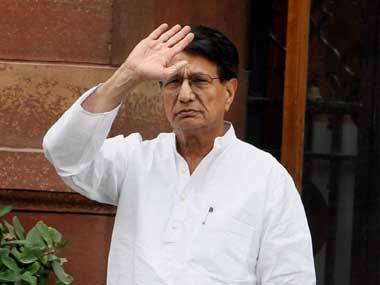New Delhi: If Civil Aviation Minister Ajit Singh has his way, India could soon begin to count on the international aviation scene.
Presently, Indian airlines such as Jet Airways, Air India and others are easily dwarfed by powerful global carriers which ensure that international traffic from India looking for onward connections is routed through their respective hub cities.
Simply put, this means an Emirates will carry Indian passengers to Dubai first and then onward to the Americas or Europe when this traffic could well have been carried by any of the Indian airlines.
[caption id=“attachment_341130” align=“alignleft” width=“380” caption=“PTI”]
 [/caption]
[/caption]
So why are Indian carriers left out in the cold? In a policy note, the civil aviation ministry has listed out a number of reasons: lesser financial clout and fleet size compared to Emirates, Etihad, Lufthansa and Singapore Airlines; operational cost advantage due to cheaper aviation fuel and lower taxation of foreign carriers; and inability of processes at Indian airports to allow hubbing.
The paper also acknowledges that India is a late entrant and foreign airports and airlines have already invested in hub development earlier. Also, airlines like Emirates have been given extensive reach to even smaller Indian cities which enables them to pick up traffic from these cities, carry it to Dubai and provide onward connections. Indian airlines have not been allowed similar access in the UAE.
Obviously, policy-making in the past has not been either conducive to hubbing or taking care of the interests of Indian airlines.
First, carriers such as Jet Airways and Kingfisher Airlines (which was earlier flying international) have suffered because of Air India’s First Right of Refusal clause.
Impact Shorts
More ShortsSecond, Sixth Freedom rights granted to some powerful foreign airlines earlier have led to the loss of substantial Indian traffic to foreign carriers. Sixth Freedom Traffic Rights refer to the right of any foreign airline to carry passengers or cargo from India to a third country via their own country.
Ajit Singh has already taken away Air India’s monopoly over international routes and the government is now going slow on granting Sixth Freedom bilateral rights to foreign carriers - but all these steps may be a bit late in the day.
According to the ministry’s own policy paper, convenient onward connections and the financial clout of its largest airline ensures that the UAE takes away one in four international passengers who would have otherwise used an Indian airport to take onward international connections. If we take the six airports in the Gulf countries together - Dubai, Doha, Sharjah, Bahrain, Abu Dhabi and Muscat, then the traffic “leakage” - which means international passengers taken away from Indian airports by other airports for onward connections - is a whopping 5.36 million passengers every year, or close to 40 percent of the international transfer traffic from India.
No wonder then that Indian airlines are minnows compared to the big fish - Emirates, Singapore Airlines, Lufthansa, etc.
Of the total international transfer traffic of 15 million a year, only 10 percent, or 1.5 million, is currently being captured by Indian airports. A whopping 50 percent goes to airport hubs in the Middle East and South East Asia.
On the Europe to South East Asia route, Emirates and Singapore Airlines account for 8 percent and 13 percent of the traffic respectively whereas the India carriers (Jet Airways, Air India and Kingfisher Airlines ) are capturing less than 1 percent. Similarly, in case of the Europe-Australasia route, Emirates and Singapore Airlines account for 14 percent and 24 percent of the traffic whereas Indian carriers have negligible presence. Hence, there is a vast economic potential that can be harnessed.
)